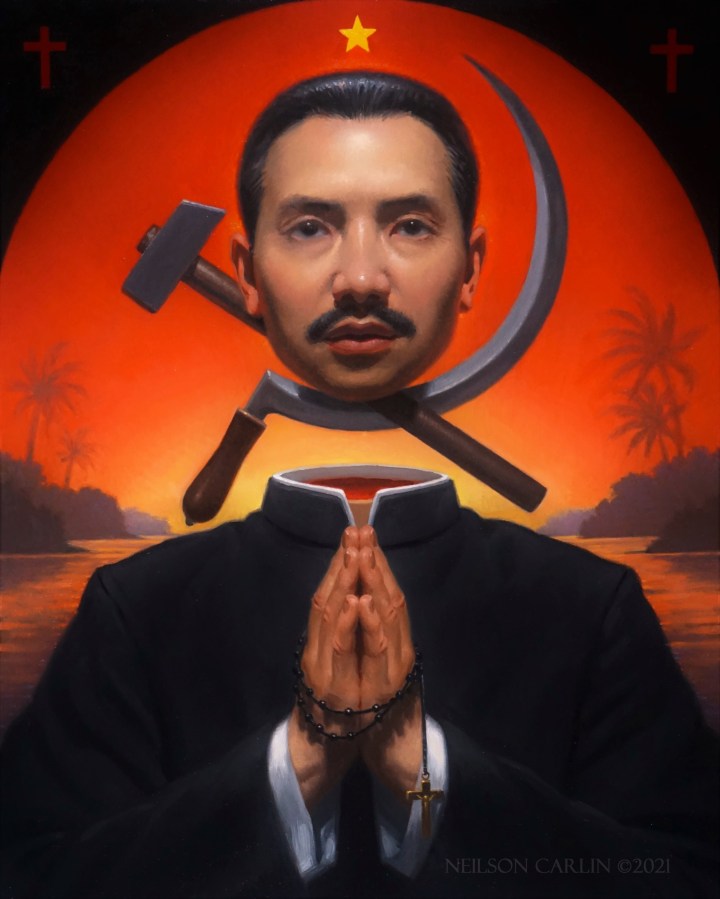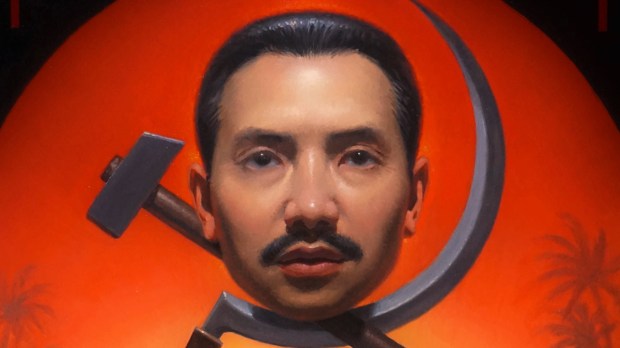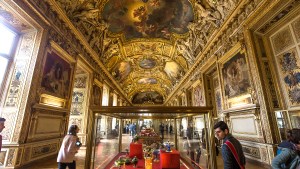The Catholic artistic tradition is filled with masterpieces from the greatest painters mankind has to offer. These masters of the craft immortalize the lives and deeds of the saints through a medium that places the viewer right alongside them. This mission was perhaps defined the best by Pope St. John Paul II, when he said:
“Every genuine artistic intuition goes beyond what the senses perceive and, reaching beneath reality’s surface, strives to interpret its hidden mystery.”
These words adorn the website of Neilson Carlin, who has recently added another masterpiece to the Catholic collection. Titled “Fr. Francis Xavier Truong Buu Diep, Servant of God,” the piece is a testament to the value of modern iconography and the valor of the martyrs.

Fr. Francis Xavier Truong Buu Diep
There are many in the West who may be unfamiliar with Fr. Francis Xavier Truong Buu Diep’s life. Born in Vietnam, in 1897, he and his father moved to Cambodia after the death of his mother. As a young adult, Diep entered the seminary and as a priest he established parishes throughout Vietnam and Cambodia.
In 1945, when war broke out in Vietnam, he was advised by his superiors to leave his parish for safety’s sake. To this, Fr. Diep refused, saying “I will live with the flock and if necessary, I will die with them.” The following year, on March 12, Fr. Diep and 70 of his parishioners were captured and martyred for their faiths.
Carlin was similarly unaware of the life and works of Fr. Diep, until he was introduced to the martyr in a chance encounter with a Vietnamese seminarian. Fr. Diep’s story immediately resonated with the artist and this led him to produce the masterful icon of the Vietnamese martyr.
The icon
The image can be shocking at first glimpse, with Fr. Diep’s head hovering over his shoulders, placed before the hammer and sickle of Communism. The most striking part, however, is the look of utter serenity on Fr. Diep’s face. This juxtaposition of the brutality of his martyrdom and the faithful acceptance of his fate is compelling and only grows more emotional the longer one looks.
These richly conveyed emotions are a staple of Carlin’s art.A quick look through his website’s gallery confirms his prowess at presenting the gritty humanity of a subject melded with the purity of the divine. Through simple brush strokes he brings figures to life in such a way that the viewer can’t help but feel closer to them.
Carlin was kind enough to speak with Aleteia about his art, his faith, and the influence of the Martyrs.
What drew you to paint Fr. Francis Xavier Truong Buu Diep?
I do work for parishes or whatever I’m commissioned to do, but left to my own time with my pieces in the studio I really focus on the martyrs. I am haunted by martyrs, the reason being that I always ask myself, “Would I be able to do the same thing with the same faith, courage, and love that they did?” and I’m never sure. I can’t know unless I would be put in that situation.
So I’m constantly thinking about martyrs and when I learn of new ones, new stories I hadn’t heard before, particularly contemporary martyrs, I’m always attracted to them. His brutal death at the hands of the Việt Minh, all because he wouldn’t abandon his parish … that is a story about a true pastor, a true shepherd, willing to put his life on the line to serve his people. That resonates with me. To me, that is a real Catholic man in every sense of the word.
When you view this finished work, what strikes you the most?
Boy, that’s hard to answer, but I can tell you what my intention was. I wouldn’t say the gore factor but the shock factor of the martyrdom.
Since I was raised Protestant and became a Catholic, I know a lot of old Protestant friends who ask why my pieces are so gory. It’s not meant to be gory. I remind them that I go to a church where there is a crucified man in front of me every day.
It is about reconciling the suffering with love and meeting it with faith and grace. To me it’s not gory, but it’s meant to make someone pause and not only recognize who this priest was, but what he endured for the faithful.
The sun appears to be setting behind the martyred saint. What does this represent?
More than creating a specific condition of a sunrise or sunset, I wanted the red in the sky. This is indicative of obviously the red oppression that Vietnam was facing at the time. So that, more or less, played into the time of day more than a sunrise or sunset. But I can certainly capitalize on what you are bringing up. If that’s the initial read, of a sunset, then it’s the sun setting on the freedom of the Vietnamese by the coming oppression under the communist order.
I’m always trying to present something that will hopefully give the viewer not a sense of hopelessness, but that these things will be conquered eventually by the acts of these martyrs. The fact that I know his name and not the people who murdered him means his story transcends whatever was going on. It will last and resonate throughout the generations far beyond the individual names of the people who carried out the atrocities.
You mentioned in your bio that you were a secular artist before you delved fully into sacred art. What were the easiest and hardest parts of making this change?
The easiest part was that it’s where my heart was. My heart was there for years, but I didn’t really realize it until my first big commission for the Church. I don’t think there was a hard part because it was a win/win scenario. I’d been wanting to break into the “Catholic market” and there was no down side to making the shift.
I wasn’t happy with the work that I was being asked to do for secular galleries. It’s not that I was being asked to do anything off color, but my spirit was not satisfied. If I tried to do something with spiritual meaning to me, I felt like I had to hide it because none of the galleries, at least none of the galleries I was dealing with, were interested in anything overtly Christian.
I think of a line from one of the Star Wars movies. I think Anakin says something like “I’m not the Jedi I’m supposed to be.” That’s the way I felt for years in secular galleries.
Who is your favorite Catholic figure to portray and why?
St. Maximilian Kolbe. When I became a Catholic, I did not know Maximilian Kolbe even existed. I took Thomas Aquinas as my Confirmation name, but if I’d known Kolbe I’d have picked him up, down, and sideways. The fact that he could bring light into a living hell is a story that everyone should know. Everyone should know his name, Catholic or not. How to meet suffering and brutality with faith and charity. The story resonated immediately with me.
He is a saint that in my own private time, I often depict, even in sketching, just so that I can think about him and meditate on his sacrifice. I keep coming back to him. I said was haunted by martyrs, but he’s the one that haunts me the most.
What advice do you have for those who are studying sacred art, or for those who are in secular art and wish to make the change?
It’s not going to get any better staying in those [secular] markets. I’ve been doing this now since 2007. I had heard that there was a long desert for Catholic artists after Vatican II. It seems like that’s changing. It seems like a lot of younger priests want more imagery and iconography in their parishes. I would say, if that’s what you want to do, find a local parish and offer to do it for them. Get your foot in the door, get a body of work going and make it known that this is your vocation.
I think that was my big revelation about the transfer from secular to sacred art. It was recognizing that before that I did art as a career and loved it, but doing work for the Church is my vocation and it is completely fulfilling. It is what I was put here to do and it took me a long time to realize that.
So if that’s your vocation, it’s not going to get any better for you, doing what you’re doing and not pursuing your calling with 100% of your being.
Visit Neilson Carlin’s website to fully explore his exceptional brand of Catholic art.
For updates on his latest releases, follow him on Facebook.


